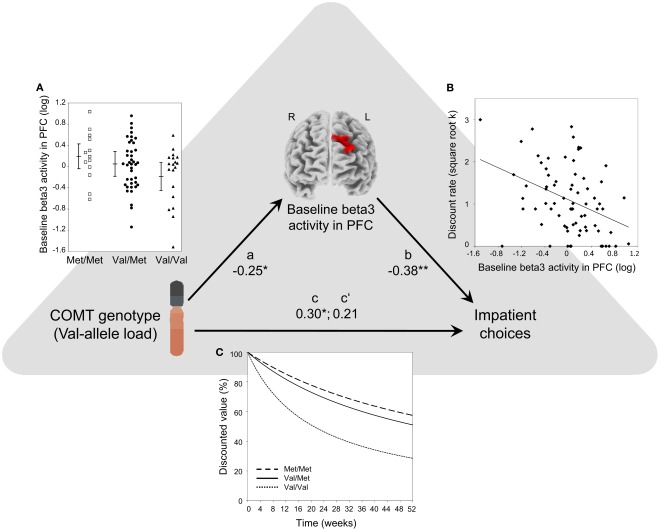Figure 2.
Path diagram of the whole-brain analysis that shows that baseline EEG beta3 activity level in the left DPFC mediates COMT-determined differences in steepness of DD. Path a: Val allele load (0, 1, or 2 Val alleles) of the COMT gene correlated negatively with baseline beta3 activity in the left DPFC. As beta3 activity indicates excitatory cortical activation, this means that a greater number of Val alleles was associated with a lower level of baseline activation in the left DPFC (β = −0.25; P = 0.03). (A) Shows mean baseline beta3 activity (log A/m2) in the left DPFC cluster for Met/Met (n = 13), Val/Met (n = 41), and Val/Val (n = 19) subjects. Group means (±1 SD) are also shown. Path b: baseline beta3 activity in the left DPFC predicts individual differences in DD (β = −0.38; P = 0.0009). (B) Shows a scatterplot and the Pearson correlation between baseline beta3 activity in left DPFC and discount rate (square-root transformed hyperbolic discount rate k; a higher discount rate indicates steeper DD, i.e., greater impatience). Path c: Val allele load correlated positively with the discount rate. Greater number of Val alleles was associated with steeper DD (β = 0.30; P = 0.01). As illustration, (C) shows hyperbolic discounting curves, computed over 52 weeks using each genotype groups’ mean discount rate (the curves illustrate subjective present-time values of a reward as a function of time; at time point 0 the subjective present-time value is set to 100% and then decreases with increasing time delay). Using bootstrapping, we constructed a 95% confidence interval for the effect size of the indirect effect (cross product a × b). Its range was between 0.01 and 0.36. A confidence interval that does not include zero indicates a significant indirect effect (P < 0.05), thus showing that baseline beta3 activity level in left DPFC significantly mediates the effect of COMT genotype on DD. Path c′: the relationship between Val allele load and DD becomes non-significant when controlling for the mediator, i.e., baseline activation in the left DPFC (β = 0.21; P = 0.07).

